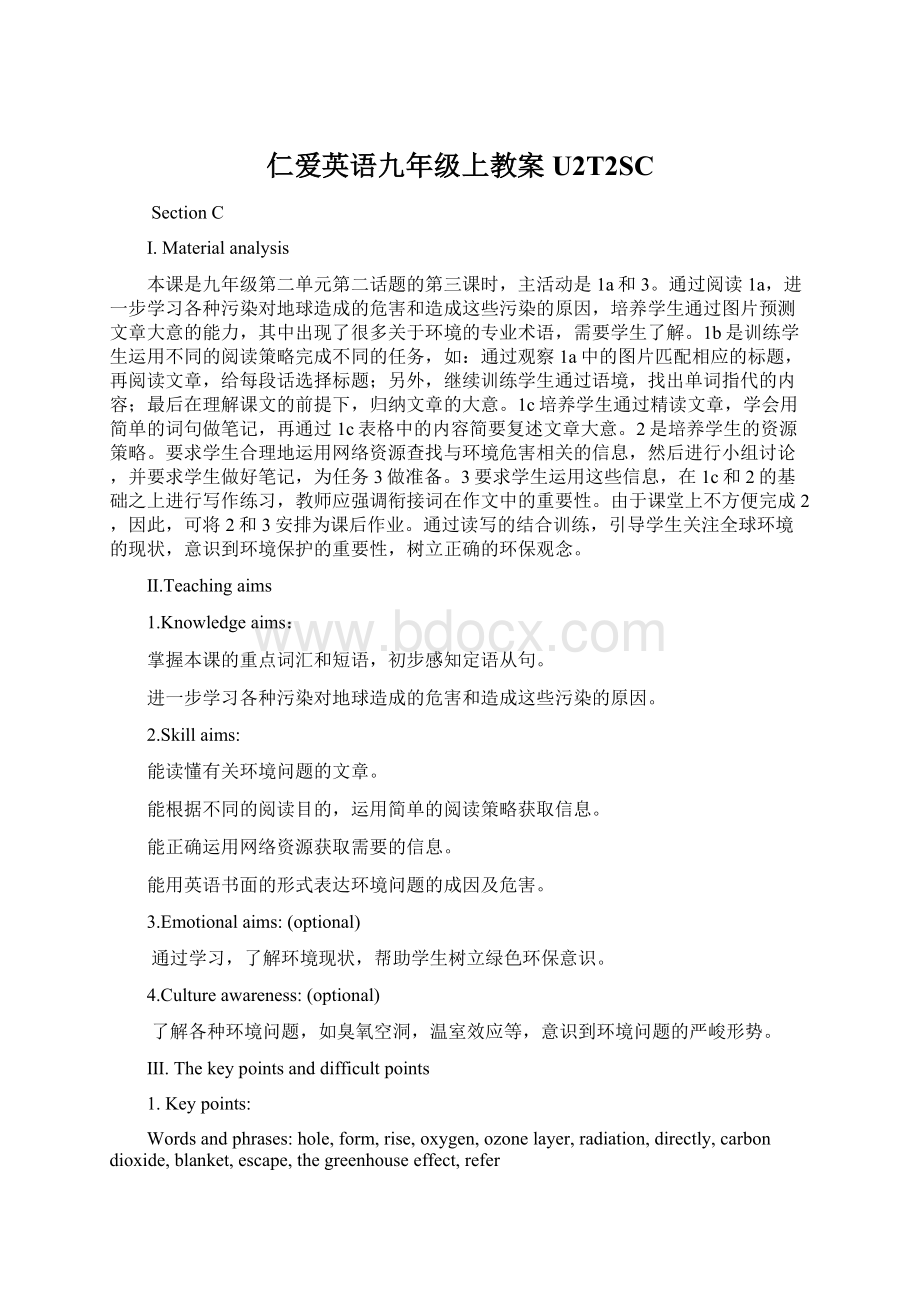仁爱英语九年级上教案U2T2SC.docx
《仁爱英语九年级上教案U2T2SC.docx》由会员分享,可在线阅读,更多相关《仁爱英语九年级上教案U2T2SC.docx(19页珍藏版)》请在冰豆网上搜索。

仁爱英语九年级上教案U2T2SC
SectionC
Ⅰ.Materialanalysis
本课是九年级第二单元第二话题的第三课时,主活动是1a和3。
通过阅读1a,进一步学习各种污染对地球造成的危害和造成这些污染的原因,培养学生通过图片预测文章大意的能力,其中出现了很多关于环境的专业术语,需要学生了解。
1b是训练学生运用不同的阅读策略完成不同的任务,如:
通过观察1a中的图片匹配相应的标题,再阅读文章,给每段话选择标题;另外,继续训练学生通过语境,找出单词指代的内容;最后在理解课文的前提下,归纳文章的大意。
1c培养学生通过精读文章,学会用简单的词句做笔记,再通过1c表格中的内容简要复述文章大意。
2是培养学生的资源策略。
要求学生合理地运用网络资源查找与环境危害相关的信息,然后进行小组讨论,并要求学生做好笔记,为任务3做准备。
3要求学生运用这些信息,在1c和2的基础之上进行写作练习,教师应强调衔接词在作文中的重要性。
由于课堂上不方便完成2,因此,可将2和3安排为课后作业。
通过读写的结合训练,引导学生关注全球环境的现状,意识到环境保护的重要性,树立正确的环保观念。
Ⅱ.Teachingaims
1.Knowledgeaims:
掌握本课的重点词汇和短语,初步感知定语从句。
进一步学习各种污染对地球造成的危害和造成这些污染的原因。
2.Skillaims:
能读懂有关环境问题的文章。
能根据不同的阅读目的,运用简单的阅读策略获取信息。
能正确运用网络资源获取需要的信息。
能用英语书面的形式表达环境问题的成因及危害。
3.Emotionalaims:
(optional)
通过学习,了解环境现状,帮助学生树立绿色环保意识。
4.Cultureawareness:
(optional)
了解各种环境问题,如臭氧空洞,温室效应等,意识到环境问题的严峻形势。
Ⅲ.Thekeypointsanddifficultpoints
1.Keypoints:
Wordsandphrases:
hole,form,rise,oxygen,ozonelayer,radiation,directly,carbondioxide,blanket,escape,thegreenhouseeffect,refer
duringthisperiod,takeaway,passthrough
Sentences:
(1)Forestshavebecomedeserts,somoreandmoresortsofanimalsandplantsaredisappearing.
(2)Asaresult,manyriversandlakesarenowdead.
(3)Toomuchharmfulradiationfromthesunpassesthroughtheholeandreachestheearthdirectly.
(4)Itcausestheleveloftheoceanstoriseandtheclimateoftheearthtochange.
(5)Whenitrainsorwhenthewindblows,theearthistakenaway.
(6)Theheatfromthesuncan’tescape,sothetemperatureisrising.
Grammar:
indefinitepronounandadverb
2.Difficultpoints:
理解有关环境方面的专业术语。
能读懂与环境问题相关的科普类文章。
能运用所学知识,写出谈论环境现状的文章。
Ⅳ.Learningstrategies
能在阅读不同体裁的材料时,运用不同的阅读策略获取信息。
善于利用插图预测科普类文章的内容。
能合理运用网络资源,拓展写作思路和开拓视野。
恰当使用连接词,使自己的作文流畅,有逻辑层次。
Ⅴ.Teachingaids
与环境相关的图片;单词卡片(如O2/oxygen;ozonelayer;radiation等);录音机;国际臭氧层保护日宣传动画片等。
Ⅵ.Teachingprocedures
Stage
(timeperiod)
Interaction
patterns
Teacheractivity
Studentactivity
Remarks
1
Gettingstudentsreadyforlearningandrevision
(2mins)
Classactivity
ChecktheSs’homework:
LettheSsgiveareportabouttheirownbadhabitsandhowtomakethecampusbetter.
T:
Hi,everyone.Lastclass,wehavetalkedsomethingabouttheschoolenvironment.Someofusmayhavesomebadhabits,andthesehabitscanaffectourcampus.Whatcanyoudotomakeourcampuslookbetter?
Pleaseshareyouropinionswithus.
S1:
IoftenforgettoturnoffthelightswhenIleavetheclassroom.Ithinkitdoesn’tmatterifthelightsareonforalittlewhile.AndIoftenwastesomepaperafterIonlyuseasmallpartofit.Iliketousenewpaper.ButnowIrealizethesehabitsarereallybadones,soIhopeeveryoneofuscansaveenergyfromnowon.
T:
Verygood.Ifyoucangivemoresuggestions,itwillbebetter.Nextone.
S2:
Ialwaysmakeloudnoisebetweenclasses.Itdisturbsothers.Ioftenthrowrubbisharoundinacornerifthereisnobody.Butfromnowon,Iwillremembertogetridofthebadhabits.Ifeveryonecanfollowtheschoolrules,ourcampuswillbecomemorebeautiful.
S3:
…
T:
Great.
Giveareportaboutyourownbadhabitsandhowtomakethecampuslookbetter.
S1:
IoftenforgettoturnoffthelightswhenIleavetheclassroom.Ithinkitdoesn’tmatterifthelightsareonforalittlewhile.AndIoftenwastesomepaperafterIuseonlyasmallpartofit.Iliketousenewpaper.Ihopeeveryoneofuscansaveenergyfromnowon.
S2:
Ialwaysmakeloudnoisebetweenclasses.Itdisturbsothers.Ioftenthrowrubbisharoundinacornerifthereisnobody.Butfromnowon,Iwillremembertogetridofthebadhabits.Ifeveryonecanfollowtheschoolrules,ourcampuswillbecomemorebeautiful.
S3:
…
用报告的形式让学生在课堂上反思自己平时的言行,有助于学生更好提升自己,培养“爱护环境从我做起,从小事做起”的意识。
2
Lead-in
(3mins)
Classactivity
Playthecartoonvideoaboutprotectingtheozonelayer.LettheSswatchanddiscusswhattheyhavelearntfromit.Takesomenotesifnecessary.
T:
Hereisavideoaboutprotectingtheozonelayer.Let’swatchitcarefully.ThenIwillaskyousomethingaboutit.
...
T:
NowLet’sfigureoutsomethingaboutozonelayer.Isozonelayerimportantorunimportant?
Ss:
It’sveryimportant
T:
Cantheozonelayerprotectus?
Ss:
Yes.
T:
Whathappenedtoitnow?
Ss:
Thereisabigholeintheozonelayer.
T:
Yes.What’stheeffectofit?
Ss:
It’sharmfultoallthelivingthings,especiallytohumansforitdoesharmtooureyesandskin.
Watchthevideoanddiscusswhattheyhavelearntfromit.Takesomenotes.
Ss:
It’sveryimportant
Ss:
Yes.
Ss:
Thereisabigholeintheozonelayer.
Ss:
It’sharmfultoallthelivingthings,especiallytohumansforitdoesharmtooureyesandskin.
…
通过播放视频,让学生了解每年的9月16日是国际臭氧层保护日,关注臭氧层的现状。
该宣传片是卡通版,不是枯燥的科教片,能够很好地吸引学生的注意力。
如果条件不允许,教师可以从课外书籍上选读一些与环境相关的文章。
3
Pre-reading
(5mins)
Classactivity
Classactivity
Step1:
Showtwopicturesofozonelayerandmorecarbondioxide.IntroducethemtotheSsbrieflytoteachthenewwords.
T:
Right.Ozoneisaspecialkindofoxygen.Itcanprotecttheearth.Nowpeopleproducelotsofharmfulchemicalsintotheair.Theycauseabigholeintheozonelayer.Sotheradiationcanpassthroughtheholeandreachtheearthdirectly.
…
(ShowthepictureofmorecarbondioxideandleadtheSstolearnthenewwordsinthesameway.)
Step2:
GuidetheSstopredictthemainideaofthepassagebythegivenpictures.
T:
NowlookatthepicturesonPage39,canyouguesswhatwewilllearninthepassage.
S1:
Somethingaboutpollution.
S2:
Trafficpollution/airpollution
S3:
Ozonelayer
S4:
Cuttingdowntrees
S5:
Carbondioxide
…
Lookatthepicturesandlearnthenewwordsaccordingtoteacher’sdescriptions.
Predictthemainideaofthepassagebythegivenpictures.
S1:
Somethingaboutpollution.
S2:
Trafficpollution
S3:
Ozonelayer
S4:
Cuttingdowntrees
S5:
Carbondioxide
…
在观看宣传片后,再介绍有关臭氧层和温室效应的英文词汇,学生容易理解,也容易掌握。
培养学生通过观察图片,预测课文内容的能力,这有助于学生在日常阅读中,快速获取信息。
4
While-reading
(20mins)
Individualwork
Individual
work
Groupwork
Step1:
LettheSsmatchthepictureswiththetitlesin1of1b,andthenreadparagraphs2-6quicklyandwritedownthepropertitleinfrontofeachparagraph.
T:
Excellent.Nowread1aquickly,matchthepictureswiththetitlesinExercise1quickly.
S1:
Picture1istrafficpollution.
S2:
Picture2istheozonelayer.
S3:
Picture3isfewertrees.
S4:
Picture4ismorecarbondioxide.
S5:
Picture5isfactorypollution.
…
T:
Right.Nowpleasereadparagraphs2-6quickly,chooseatitleforeachparaandwritedowninfrontofit.
…
T:
OK,let’schecktheanswertogether.
S6:
Para2isfewertrees.
S7:
Para3istrafficpollution.
S8:
Para4isfactorypollution.
S9:
Para5istheozonelayer.
S10:
Para6ismorecarbondioxide.
Step2:
LeadtheSstoreadparagraph1,5and6,findthewordsinExercise2,3and4andguessthemeaningsofthemaccordingtothecontent.
T:
Great.Nowreadparagraph1,5and6,findthewordsinExercise2,3and4andguessthemeaningsofthemaccordingtothecontent.
…
T:
Whatdoes“ourplanet”meaninthispara?
S1:
Itmeans“theearth”.
T:
Whatdoestheword“blanket”referto?
S2:
Carbondioxidearoundtheearth.
T:
Whatdoestheword“it”inPara5referto?
S3:
Itrefersto“O3”.
…
Step3:
LettheSsread1acarefully,choosethebesttitleforthepassageandfinish5in1b.Thencompletethenotesin1caccordingto1a.
T:
Pleasereadthepassageandchoosethebesttitleforthepassage.
…
T:
OK.Haveyougotthemainideaofthepassage?
S4:
Yes.Environmentalproblems.
T:
Right.Trytofinishthenotesin1caccordingtothepassage.Payattentiontousethekeywordswhentakingnotes.Youcandiscusswithyourgroupmembers.
…
T:
OK.Haveyoufinished?
What’stheeffectoftrafficpollution?
S5:
Peoplehavehealthproblem.
T:
What’stheeffectoffactorypollution?
S6:
Factoriesmaketheriverandlakesdead.
S7:
…
…
T:
That’sright.Youdidverywell.
Matchthepictureswiththetitlesin1of1b,andthenreadparagraphs2-6quicklyandwritedownthetitleinfrontofeachparagraph.
S1:
Picture1istrafficpollution..
S2:
Picture2istheozonelayer.
S3:
Picture3isfewertrees.
S4:
Picture4ismorecarbondioxide.
S5:
Picture5isfactorypollution.
…
S6:
Para2isfewertrees.
S7:
Para3istrafficpollution.
S8:
Para4isfactorypollution.
S9:
Para5istheozonelayer.
S10:
Para6ismorecarbondioxide.
Readparagraph1,5and6,findthewordsinExercise2,3and4andguessthemeaningsofthemaccordingtothecontent.
S1:
Itmeans“theearth”.
S2:
Carbondioxidearoundtheearth.
S3:
Itrefersto“O3”.
…
Read1acarefully,choosethebesttitleforthepassageandfinish5in1b.Thencompletethenotesin1caccordingto1a.
S4:
Yes.Environmentalproblems.
S5:
Peoplehavehealthproblem.
S6:
Factoriesmaketheriverandlakesdead.
…
教师在安排1b的阅读任务时,要注意以下两点:
1.引导学生用不同的阅读策略完成不同的阅读任务。
2.任务的安排要有层次性,从易到难。
训练学生通过上下文猜测单词指代的内容,有助于学生更好的理解课文。
该环节的三个小任务是用相同的方法获得信息,因此,可以一次性完成。
归纳文章中心思想,是学生较为头疼的题目,因此,如果文章较长的话,最好把它放到最后一个环节处理,降低难度,
教师要引导学生用排除法作出正确的选择。
5
Post-reading
(12mins)
Individualwork,Groupworkandclassactivity
Pairwork
Step1:
LettheSsread1acarefully,findoutthedifficultpoints,andlistthemontheBb.
T:
Read1aagainandfindoutthedifficultpoints.PleasecollectthemingroupsandlistthemonyoursmallBb.
…
T:
OK,nowlookatthepointsofGroupOneontheBb.Lookatthisone“Whatdoestheword“others”referto?
”Whocandealwithit?
S1:
Somethingwehavedone.
T:
OK,lookatthissentence“theearthistakenaway”.Whocantranslateit?
S2:
Itmeans“泥土被带走了”inChinese.
…
Step2:
GuidetheSstoretellthep